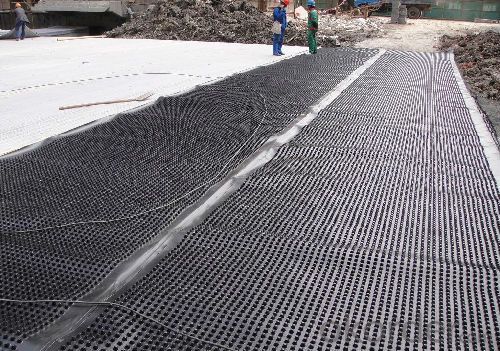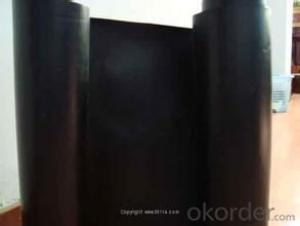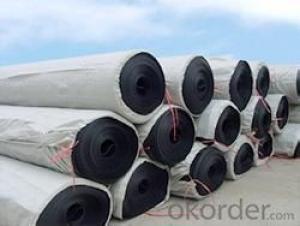Geotextiles Anti-grass Cloth BT60-42
- Loading Port:
- China Main Port
- Payment Terms:
- TT or LC
- Min Order Qty:
- -
- Supply Capability:
- -
OKorder Service Pledge
OKorder Financial Service
You Might Also Like
1.Introduction
The anti-grass cloth is a kind of vertical and horizontal weaving plastic woven cloth,
It has good quality of permeability,water seepage and Prevention and control of weeds.
Widely used in gardening and agriculture.
We develop and produce the ground of antigrass cloth, solve the problem above,
provides a good permeability, fast ooze water, prevention and control of weeds,
prevent root drill out of the ground a gardening with ground grass cloth,The ground
of grass cloth including several vertical and horizontal weaving together black plastic
weaving cloth, prevent the sunshine through the ground, against exposure to the weeds,
grass cloth that weeds could not for photosynthesis, achieve prevent weeds, and
uv-resistance to mildew, has a certain strength and abrasion resistance This kind of
anti-grass cloth can not only prevent plant roots under the ground, beautify the
environment, improve labor efficiency and economic benefit, prevention and
control of environmental pollution, reduce pesticide use, also can prevent insects
and small animals and grow.
2.Characteristic
1.Prevent leakage disposal in landfill or waste water or waste dregs disposing field.
2.River bank ,lake dam ,mine remainings ,resevoir ,tunnel ,liquid storage pool(pit ,mine)
3.Preventing leakage in subway ,basement ,tunnel ,hole .
4.Anti-salt leakage in roadbed and other ground sill.
5.The plane direction laying of dam ,the vertical direction laying for ground sill.used in the
construction fence and waste material field.
6.Used in ground sill of road ,highway ,railway and waterproof layer of welling clay and wet
collapsed loess.
7.Preventing leakage on rooftop.
3. Specification

4.Reference Picture



- Q:How do geotextiles aid in the reduction of soil compaction?
- Geotextiles aid in the reduction of soil compaction by acting as a barrier between the soil and external forces. They distribute the load over a larger area, reducing the pressure on the soil. This helps to minimize soil compaction and maintain the structural integrity of the soil, making it more resistant to compression.
- Q:How do geotextiles contribute to groundwater protection?
- Geotextiles contribute to groundwater protection by acting as a barrier between the soil and any potential contaminants. They prevent the infiltration of pollutants into the groundwater by providing a filtration layer that allows water to pass through while trapping harmful substances. Additionally, geotextiles help in stabilizing the soil, reducing erosion and sedimentation that can impact the quality of groundwater.
- Q:How are geotextiles used in geotechnical engineering?
- Geotextiles are commonly used in geotechnical engineering to provide reinforcement, filtration, separation, and drainage in various construction projects. These permeable fabrics are placed within soil or rock structures to enhance their performance, prevent soil erosion, improve stability, and control water flow. Geotextiles are especially useful in road construction, embankments, retaining walls, landfills, and coastal engineering, as they offer cost-effective solutions and contribute to the sustainability and longevity of these structures.
- Q:Can geotextiles be used in coastal protection projects?
- Yes, geotextiles can be used in coastal protection projects. Geotextiles are materials that are designed to be placed in the ground or water and provide soil stabilization and erosion control. In coastal areas, they can be used to prevent erosion of beaches or dunes by acting as a barrier against wave energy and preventing sediment loss. Geotextiles can also be employed in the construction of revetments, breakwaters, or other coastal structures to enhance their stability and longevity.
- Q:Can geotextiles be used in geothermal energy projects?
- Yes, geotextiles can be used in geothermal energy projects. Geotextiles are often used as a separation and filtration layer in geothermal systems to prevent the mixing of different types of soils and to enhance drainage. They can also be employed as a reinforcement material to increase the stability of the ground during the installation of geothermal wells.
- Q:How do geotextiles help in preventing soil erosion in vineyards?
- Geotextiles help in preventing soil erosion in vineyards by acting as a protective barrier. They are placed on the soil surface between the rows of vines, effectively reducing the impact of heavy rainfall, wind, and water runoff. The geotextiles allow water to pass through while retaining the soil particles, preventing them from being washed away. This helps in maintaining the stability of the soil, reducing erosion and preserving the nutrient-rich topsoil crucial for vine growth and productivity.
- Q:Can geotextiles be used in railway track construction?
- Yes, geotextiles can be used in railway track construction. They provide various benefits such as soil stabilization, filtration, and drainage, helping to enhance the performance and longevity of the track. Geotextiles can help prevent the mixing of different soil layers, reduce soil erosion, and improve the track's load-bearing capacity. They are commonly used as a separation layer between the subgrade and ballast, providing additional support and stability to the track.
- Q:Geotextile detection sampling, how many meters
- General a square meter can be, I professional production
- Q:What are the different design considerations for geotextile applications?
- Some of the different design considerations for geotextile applications include the type and properties of the geotextile material, the site conditions and requirements, the desired functions and performance criteria, the installation and construction methods, and the long-term durability and maintenance requirements. Additionally, factors such as cost-effectiveness, environmental impact, and regulatory compliance also need to be taken into account during the design process.
- Q:Can geotextiles be used in green roof drainage systems?
- Yes, geotextiles can be used in green roof drainage systems. Geotextiles, which are permeable fabrics, can be placed within the drainage layer of a green roof system to enhance water flow and filtration. They help to prevent clogging and ensure efficient drainage, promoting healthier plant growth and preventing water accumulation on the roof.
1. Manufacturer Overview |
|
|---|---|
| Location | |
| Year Established | |
| Annual Output Value | |
| Main Markets | |
| Company Certifications | |
2. Manufacturer Certificates |
|
|---|---|
| a) Certification Name | |
| Range | |
| Reference | |
| Validity Period | |
3. Manufacturer Capability |
|
|---|---|
| a)Trade Capacity | |
| Nearest Port | |
| Export Percentage | |
| No.of Employees in Trade Department | |
| Language Spoken: | |
| b)Factory Information | |
| Factory Size: | |
| No. of Production Lines | |
| Contract Manufacturing | |
| Product Price Range | |
Send your message to us
Geotextiles Anti-grass Cloth BT60-42
- Loading Port:
- China Main Port
- Payment Terms:
- TT or LC
- Min Order Qty:
- -
- Supply Capability:
- -
OKorder Service Pledge
OKorder Financial Service
Similar products
New products
Hot products
Hot Searches
Related keywords






























